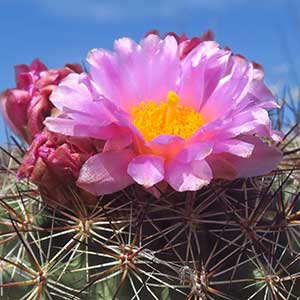Pediocactus nigrispinus
Pediocactus peeblesianus
black-spine snowball cactus, Columbia Plateau cactus, dark-spine ball cactus, snowball cactus
Navajo pincushion cactus, Peebles Navajo cactus
depressed-ovoid to elongate-ovoid, 5–30 × 5–15 cm;
areoles oval, villous.
gray-green, obovoid, globose or depressed-globose, 2–6.5 × 1.5–5.5 cm;
areoles circular, lanulose.
smooth, hard and rigid, distinguishable as radial and central;
radial spines 10–30 per areole, spreading at right angles to tubercles, nearly straight, white to dull reddish brown, 8–20 mm;
central spines 6–12 per areole, widely spreading or nearly erect, reddish brown to nearly black, rigid, straight or slightly curved, base yellow or cream, 15–35 mm, less than 1 mm diam. at base.
soft and corky or spongy, harder at tips, white to pale gray, all radial or with 1 central and sometimes 0–1 intermediate spines per areole;
radial spines 3–7 per areole, 2–9 × 0.5–1 mm; intermediate spines curved upward, 8–21 × 0.7–1.5 mm;
central spine, when present, 5–18 × 1 mm.
1–3.5 × 2.5–5 cm;
scales and outer tepals of flower tube minutely toothed, laciniate, or entire and undulate;
outer tepals with greenish brown midstripes, oblong-cuneate, 12–25 × 4.5–9 mm;
inner tepals white, pink, magenta, yellow, or yellow-green, 19–27 × 5–10 mm.
1–1.4 × 1.5–2.5 cm;
scales and outer tepals minutely toothed or denticulate or entire and undulate;
outer tepals with brown-purple midstripes, oblanceolate, 5–13 × 2–4.5 mm;
inner tepals cream, yellow, or yellowish green, lanceolate, 6–12(–15) mm.
green tinged with red, drying reddish brown, short cylindric, 6–11 × 5–10 mm.
green, drying reddish brown, turbinate, 6–11 × 5–8 mm.
gray to black, 2–3 × 1.5–2 mm, papillate but not rugose.
dark brown to black, 3 × 2 mm, papillate and rugose.
Pediocactus nigrispinus
Pediocactus peeblesianus
No known morphologic character supports the taxonomic recognition of infraspecific taxa within Pediocactus nigrispinus. Characteristics used to distinguish the three described subspecies almost completely overlap. Pediocactus nigrispinus has been referred to P. simpsonii var. robustior (J. M. Coulter) L. D. Benson, which remains well within the range of variation for P. simpsonii. An unpublished study by J. M. Porter et al. of noncoding chloroplast DNA sequences shows P. simpsonii is less closely related to P. nigripsinus than to P. knowltonii, P. winkleri, and P. despainii.
(Discussion copyrighted by Flora of North America; reprinted with permission.)
Subspecies 2 (2 in the flora).
(Discussion copyrighted by Flora of North America; reprinted with permission.)
1. Central spines 0; radial spines (3-)4(-5) per areole; stems unbranched | subsp. peeblesi |
1. Central spines (0-)1; radial spines 6-7 per areole; stems 0-4-branched | subsp. fickeise |


